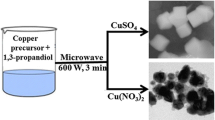Abstract
Uptake to cuprous oxide (Cu2O) nanoparticle synthesis with various particle sizes and shapes via supersaturation chemistry approach (LaMer model) has been conducted. Ascorbic acid and maltodextrine as reducing agents and polyvinylpyrrolidone (PVP) as a surfactant were utilized for synthesis of Cu2O nanoparticles in aqueous solution. The narrow particle size range was achieved by controlling the kinetics of nucleation and growth of particles to satisfy LaMer theory. This mean was performed utilizing different reducing agents (ascorbic acid and maltodextrin) and also, changing the reducing agent addition condition. The results showed the reducing agent addition condition, varying the size of Cu2O nanoparticles from 89 nm to 74 nm for drop-wisely and at-once routes, respectively. The samples were characterized by XRD, SEM, and UV-Vis spectroscopy. The results indicate the shape of as-prepared cuprous oxide nanoparticles have close relationship with thermodynamic and kinetic conditions, and also reducing addition condition.
Similar content being viewed by others
References
M. A. El-Sayed, Acc. Chem. Res., 37, 326 (2004).
A. P. Alivisatos, Endeavour, 21, 56 (1997).
A. P. Alivisatos, Science, 271, 933 (1996).
Y. Yin and A. P. Alivisatos, Nature, 437, 664 (2005).
C.B. Murray, S. Sun, H. Doyle and T. Betley, Mater. Res. Bull., 26, 985 (2001).
X. Peng, J. Wickham and A. P. Alivisatos, J. Am. Chem. Soc., 120, 5343 (1998).
S. Mahshid, M. Askari, M. Sasani Ghamsari, N. Afshar and S. Lahuti, J. Alloys Compd., 478, 586 (2009).
E. E. Finney and R. G. Finke, J. Colloid Interface Sci., 317, 351 (2008).
R. Rioux (Ed.), Model systems in catalysis: single crystals to supported enzyme mimics, Springer, New York (2010).
J. A. Rodriguez, Synthesis, Properties and applications of oxide nanomaterials, Wiley-VCH, Weinheim (2007).
B. Delmon, G. Ertl, H. Knözinger and J. Weitkamp (Eds.), Handbook of heterogeneous catalysis, Wiley-VCH, Weinheim (1997).
H. H. Kung, Transition metal oxides: surface chemistry and catalysis, Elsevier, Amsterdam (1989).
X. Wang, J.C. Hanson, A. I. Frenkel, J.Y. Kim and J.A. Rodriguez, J. Phys. Chem. B, 108, 13667 (2004).
A. O. Musa, T. Akomolafe and M. J. Carter, Sol. Energy Mater. Sol. Cells, 51, 305 (1998).
J. T. Zhang, J. F. Liu, Q. Peng, X. Wang and Y. Li, Chem. Mater., 18, 867 (2006).
Z. Zheng, B. Huang, Z. Wang, M. Guo, X. Qin and X. Zhang, J. Phys. Chem., 113, 14448 (2009).
W.C. Huang, L.M. Lyu, Y.C. Yang and M. H. Huang, J. Am. Chem. Soc., 134, 1261 (2012).
P. Poizot, S. Laruelle, S. Grugeon, L. Dupont and J.M. Taracon, Nature, 407, 496 (2000).
Y. J. Lee, S. Kim, S. H. Park, H. Park and Y. D. Huh, Mater. Lett., 65, 818 (2011).
L. Zhang and H. Wang, J. Phys. Chem., 115, 18479 (2011).
C. Lu, L. Qi, J. Yang, X. Wang, D. Zhang and J. Xie, Adv. Mater., 17, 2562 (2005).
C. H. Kuo and M.H. Huang, J. Am. Chem. Soc., 130, 12815 (2008).
Z. C. Orel, A. Anžlovar, G. Draži and M. Zigon, Cryst. Growth Des., 7, 453 (2007).
P. Grez, F. Herrera, G. Riveros, R. Henríquez, A. Ramírez and E. Muñoz, Mater. Lett., 92, 413 (2013).
H. Bao, W. Zhang, D. Shang, Q. Hua, Y. Ma and Z. Jiang, J. Phys. Chem., 114, 6676 (2010).
C. H. Kuo, C. H. Chen and M. H. Huang, Adv. Funct. Mater., 17, 3773 (2007).
Y. Xu, H. Wang, Y. Yu, L. Tian, W. Zhao and B. Zhang, J. Phys. Chem., 115, 15288 (2011).
Y. Zhang, B. Deng, T. Zhang, D. Gao and A.W. Xu, J. Phys. Chem., 114, 5073 (2010).
Z. Zhang, H. Che, Y. Wang, J. Gao, L. Zhao and X. She, Ind. Eng. Chem. Res., 51, 1264 (2012).
E. Ko, J. Choi, K. Okamoto, Y. Tak and J. Lee, ChemPhysChem, 7, 1505 (2006).
L. Gou and C. J. Murphy, Nano Lett., 3, 231 (2003).
V. K. LaMer and R. H. Dinegar, J. Am. Chem. Soc., 72, 4847 (1950).
T. Sugimoto, J. Colloid Interface Sci., 309, 106 (2007).
T. Sugimoto, F. Shiba, T. Sekiguchi and H. Itoh, Colloids Surf., A, 164, 183 (2000).
A.G.V. Poot, G. R. Gattorno, O. E. S. Dominguez, R. T. P. Diaz, M. Pesqueira and G. Oskam, Nanoscale, 2, 2710 (2010).
D. Ma, H. Liu, H. Yang, W. Fu, Y. Zhang, M. Yuan, P. Sun and X. Zhou, Mater. Chem. Phys., 116, 458 (2009).
R. Viswanatha and D. D. Sarma, Chem. Eur. J., 12, 180 (2006).
Y. Bai, T. Yang, Q. Gu, G. Cheng and R. Zheng, Powder Technol., 227, 35 (2012).
L. Wang, G. Wei, B. Qi, H. Zhou, Zh. Liu, Y. Song, X. Ang and H. Li, Appl. Surf. Sci., 252, 2711 (2006).
G. Gao, H. Wu, R. He and D. Cui, Corros. Sci., 52, 2804 (2010).
G. Carotenuto, S. Denicola and L. Nicolais, J. Nanopart. Res., 3, 469 (2001).
Author information
Authors and Affiliations
Corresponding author
Rights and permissions
About this article
Cite this article
Arshadi, S., Moghaddam, J. & Eskandarian, M. LaMer diagram approach to study the nucleation and growth of Cu2O nanoparticles using supersaturation theory. Korean J. Chem. Eng. 31, 2020–2026 (2014). https://doi.org/10.1007/s11814-014-0130-3
Received:
Accepted:
Published:
Issue Date:
DOI: https://doi.org/10.1007/s11814-014-0130-3




